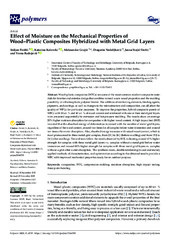Приказ основних података о документу
Effect of Moisture on the Mechanical Properties of Wood–Plastic Composites Hybridized with Metal Grid Layers
| dc.creator | Perišić, Srđan | |
| dc.creator | Kalevski, Katarina | |
| dc.creator | Grujić, Aleksandar | |
| dc.creator | Nedeljković, Dragutin | |
| dc.creator | Stajić-Trošić, Jasna | |
| dc.creator | Radojević, Vesna | |
| dc.date.accessioned | 2024-01-11T10:57:21Z | |
| dc.date.available | 2024-01-11T10:57:21Z | |
| dc.date.issued | 2023 | |
| dc.identifier.issn | 2073-4360 | |
| dc.identifier.uri | http://TechnoRep.tmf.bg.ac.rs/handle/123456789/7074 | |
| dc.description.abstract | Wood–plastic composites (WPCs) are some of the most common modern composite materials for interior and exterior design that combine natural waste wood properties and the molding possibility of a thermoplastic polymer binder. The addition of reinforcing elements, binding agents, pigments, and coatings, as well as changes to the microstructure and composition, can all affect the quality of WPCs for particular purposes. To improve the properties, hybrid composite panels of WPCs with 30 wt. % and 40 wt. % of wood content and reinforced with one or three metal grid layers were prepared sequentially by extrusion and hot pressure molding. The results show an average 20% higher moisture absorption for composites with higher wood content. A high impact test (HIT) revealed that the absorbed energy of deformation increased with the number of metal grid layers, regardless of the wood content, around two times for all samples before water immersion and around ten times after water absorption. Also, absorbed energy increases with raised wood content, which is most pronounced in three-metal-grid samples, from 21 J to 26 J (before swelling) and from 15 J to 24 J (after swelling). Flexural tests follow the trends observed by HIT, indicating around 65% higher strength for samples with three metal grid layers vs. samples without a metal grid before water immersion and around 80% higher strength for samples with three metal grid layers vs. samples without a grid after water absorption. The synthesis route, double reinforcing (wood and metal), applied methods of characterization, and optimization according to the obtained results provide a WPC with improved mechanical properties ready for an outdoor purpose. | sr |
| dc.language.iso | en | sr |
| dc.publisher | MDPI | sr |
| dc.relation | info:eu-repo/grantAgreement/MESTD/inst-2020/200026/RS// | sr |
| dc.relation | info:eu-repo/grantAgreement/MESTD/inst-2020/200287/RS// | sr |
| dc.relation | info:eu-repo/grantAgreement/MESTD/inst-2020/200135/RS// | sr |
| dc.rights | openAccess | sr |
| dc.rights.uri | https://creativecommons.org/licenses/by/4.0/ | |
| dc.source | Polymers | sr |
| dc.subject | composites | sr |
| dc.subject | compression molding | sr |
| dc.subject | high impact testing | sr |
| dc.subject | moisture absorption | sr |
| dc.subject | three-point bending | sr |
| dc.subject | WPC | sr |
| dc.title | Effect of Moisture on the Mechanical Properties of Wood–Plastic Composites Hybridized with Metal Grid Layers | sr |
| dc.type | article | sr |
| dc.rights.license | BY | sr |
| dc.citation.issue | 24 | |
| dc.citation.spage | 4705 | |
| dc.citation.volume | 15 | |
| dc.identifier.doi | 10.3390/polym15244705 | |
| dc.identifier.fulltext | http://TechnoRep.tmf.bg.ac.rs/bitstream/id/19539/Effect_of_Moisture_pub_2023.pdf | |
| dc.identifier.scopus | 2-s2.0-85180650199 | |
| dc.type.version | publishedVersion | sr |

